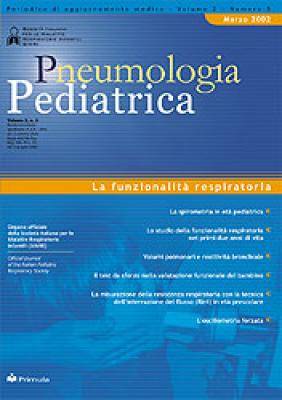Archivio > Vai alle uscite del 2002 > Vai aVolume 2, Numero 5 - Marzo 2002
- La funzionalità respiratoria
La spirometria in età pediatrica - Pulmonary function testing in children

Riassunto. I test di funzionalità respiratoria permettono al medico di documentare la normalità od il grado di alterazione della funzionalità respiratoria e di monitorare l’effetto della crescita, di malattie e di terapie sulla funzionalità respiratoria stessa. I principali parametri spirometrici sono FVC, FEV1 e FEF25-75. Prima di interpretare i risultati della spirometria, è necessario valutare la qualità delle prove eseguite. Quindi si valuterà se i risultati ottenuti permettono di classificare la spirometria in normale o alterata. Se la spirometria risulta alterata, si valuteranno il tipo e il grado di alterazione. Oltre a confrontare i valori spirometrici con valori standard di riferimento, è importante eseguire una valutazione longitudinale della funzionalità respiratoria in ciascun paziente. Nel bambino, cambiamenti della funzionalità respiratoria nel tempo rappresentano la misura più sensibile per il monitoraggio di malattie respiratorie. Sebbene i test di funzionalità respiratoria non consentano di porre una diagnosi specifica, essi permettono di classificare le malattie respiratorie come ostruttive, restrittive o miste. Le malattie respiratorie di tipo ostruttivo, come l’asma, sono caratterizzate da una riduzione dei flussi espiratori e di alcuni volumi polmonari con una riduzione dell’indice di Tiffaneau. In aggiunta, il test di broncodilatazione è un’utile prova per valutare la reversibilità della limitazione al flusso aereo.
Summary. Pulmonary function tests enable clinicians to document normality or the degree of impairment of lung function and to monitor the effect of growth, disease, or treatment on lung function. Forced expiratory maneuvers may be expressed either as volume-time spirograms or maximal expiratory flow-volume curves. The primary spirometric indeces are forced FVC, FEV1 and FEF25-75. Prior to attempting to interpret pulmonary function test results in physiologic terms, the quality of the measurements made should be assessed. After that, the interpreter’s job is first to establish whether the results are normal or abnormal. To discern abnormality from normality, tests results need to be compared with reference standards. In longitudinal testing, a patient’s pulmonary function is followed over time, compared with the patient’s usual results. In children, changes in pulmonary function over time provide the most sensitive measure of the presence or absence of respiratory disease. Most lung disease can be classified as obstructive, restrictive, or mixed-type processes. Although pulmonary function studies do not provide a specific diagnosis, they do suggest possible diagnostic categories that are associated with each of these physiologic patterns of respiratory impairment. Obstructive lung disease refers to a group of ventilatory disorders characterized by airflow limitation during expiration and can be identified by reduction in flow rates and alterations in some lung volumes, with a reduction in the FEV1/FVC ratio. Additionally, the assessment of airflow reversibility is a quick and useful adjunct to baseline spirometry.






